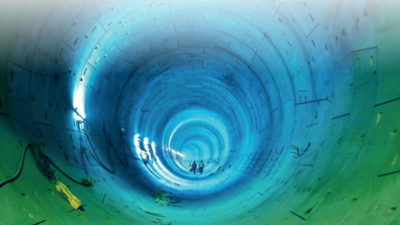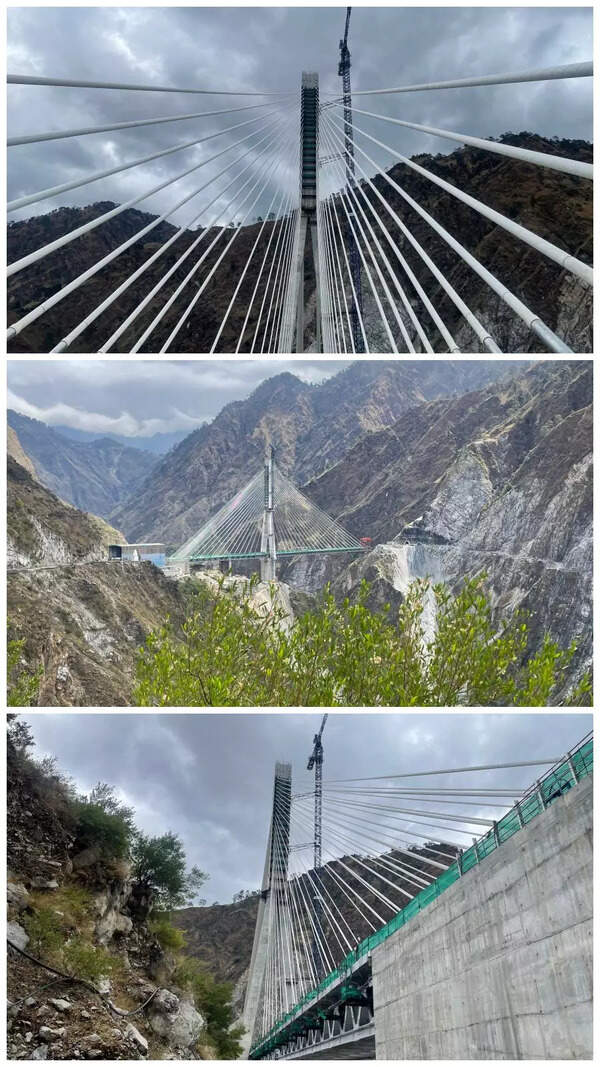- News
- City News
- delhi News
- Cross-passages in tunnels for safe RRTS ride
Trending Topics
Cross-passages in tunnels for safe RRTS ride

There will be four tunnels on the RRTS corridor in Delhi, in which 12 cross-passages will be constructed
NEW DELHI: A new Australian tunnelling technology is being used for the ongoing construction of the underground stretch of Delhi-Ghaziabad-Meerut Regional Rapid Transit System (RRTS) to create a cross-passage between tunnels every 250 metres for the safety of commuters.
"In case of an emergency, if train operations in one tunnel stop due to any unforeseen reasons, then commuters can be evacuated through these cross-passages from the other tunnel," said an official of National Capital Region Transport Corporation (NCRTC), which is executing the project.

There will be four tunnels on the RRTS corridor in Delhi, in which 12 cross-passages will be constructed. Of these, eight cross-passages will be constructed in both the 3km-long parallel tunnels that are being built between New Ashok Nagar and Anand Vihar. The remaining four cross-passages will be constructed in the 2km-long parallel tunnels that are being built between Anand Vihar and Sahibabad.
Similarly, a total of six tunnels, with nine cross-passages, are being constructed in Meerut on the Delhi-Ghaziabad-Meerut corridor. Six cross-passages in the 2km-long parallel tunnels are being constructed between Bhainsali and Meerut Central. While two cross-passages in the 1km-long parallel tunnels will be constructed between Bhainsali and Begumpul, one cross-passage will be built in the 700metre-long parallel tunnels between Gandhi Bagh and Begumpul. For the construction of the cross-passage, the sequential excavation method has been adopted.
"First, an inner line is drawn on the soil with the help of a steel plate, a girder and wire mesh. That is the area where the excavation to be done for the cross-passage is marked. The soil is excavated with the help of small machines operated by hand. Rock bolts are used to stabilise the soil," said an official.
The official added that during this construction process, the soil pressure and its effect on the surface are continuously checked through instruments.
"With the construction of the cross-passage, it is reinforced with concrete, then tunnel rings are installed to give it more strength and stability. This method is effective for tunnel construction or cross-passage in small and curved places," said the official.
At present, about 90-meter-long tunnel boring machine, called Sudarshan, is being used for tunnelling in the RRTS project. For the first time in any urban mass transit project in India, tunnels of 6.5-metre diameter are being constructed. The safety measures taken include ventilation ducts and side walkways that are 60-90 cm wide.
The 17-km-long priority section between Sahibabad and Duhai is expected to become operational much before schedule. However, the entire corridor from Delhi to Meerut is targeted to be open for the public in 2025.
"In case of an emergency, if train operations in one tunnel stop due to any unforeseen reasons, then commuters can be evacuated through these cross-passages from the other tunnel," said an official of National Capital Region Transport Corporation (NCRTC), which is executing the project.

There will be four tunnels on the RRTS corridor in Delhi, in which 12 cross-passages will be constructed. Of these, eight cross-passages will be constructed in both the 3km-long parallel tunnels that are being built between New Ashok Nagar and Anand Vihar. The remaining four cross-passages will be constructed in the 2km-long parallel tunnels that are being built between Anand Vihar and Sahibabad.
Similarly, a total of six tunnels, with nine cross-passages, are being constructed in Meerut on the Delhi-Ghaziabad-Meerut corridor. Six cross-passages in the 2km-long parallel tunnels are being constructed between Bhainsali and Meerut Central. While two cross-passages in the 1km-long parallel tunnels will be constructed between Bhainsali and Begumpul, one cross-passage will be built in the 700metre-long parallel tunnels between Gandhi Bagh and Begumpul. For the construction of the cross-passage, the sequential excavation method has been adopted.
"First, an inner line is drawn on the soil with the help of a steel plate, a girder and wire mesh. That is the area where the excavation to be done for the cross-passage is marked. The soil is excavated with the help of small machines operated by hand. Rock bolts are used to stabilise the soil," said an official.
The official added that during this construction process, the soil pressure and its effect on the surface are continuously checked through instruments.
"With the construction of the cross-passage, it is reinforced with concrete, then tunnel rings are installed to give it more strength and stability. This method is effective for tunnel construction or cross-passage in small and curved places," said the official.
At present, about 90-meter-long tunnel boring machine, called Sudarshan, is being used for tunnelling in the RRTS project. For the first time in any urban mass transit project in India, tunnels of 6.5-metre diameter are being constructed. The safety measures taken include ventilation ducts and side walkways that are 60-90 cm wide.
The 17-km-long priority section between Sahibabad and Duhai is expected to become operational much before schedule. However, the entire corridor from Delhi to Meerut is targeted to be open for the public in 2025.
Start a Conversation
FOLLOW US ON SOCIAL MEDIA
FacebookTwitterInstagramKOO APPYOUTUBE










